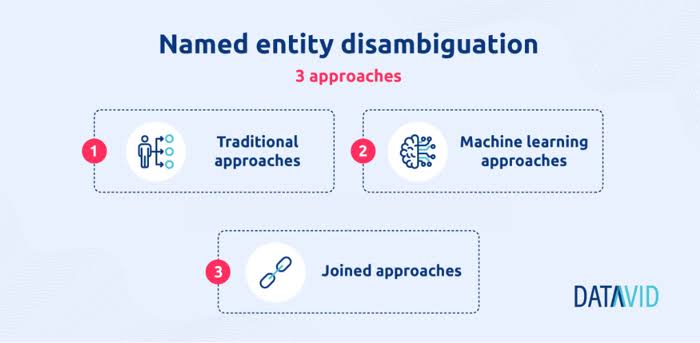Explore named entity disambiguation, a crucial natural language processing task that resolves ambiguity in text. Learn about various approaches including rule-based, machine learning, and hybrid methods, and understand the challenges and applications in improving accuracy and relevance in text data.
In field of natural language processing (NLP) named entity disambiguation (NED) plays crucial role. It resolves ambiguity within textual data. This is done by accurately identifying and linking named entities to appropriate real-world references. Named entities are terms or phrases in text. They refer to specific people, organizations locations, or other distinct entities. Disambiguating these entities is vital. It improves accuracy and usefulness of various NLP applications. These include information retrieval knowledge extraction and machine translation.
Understanding Named Entity Disambiguation
Named entity disambiguation involves resolving ambiguity when multiple entities share same name or when single entity's name is referenced in different contexts. For example term "Apple" could refer to either technology company or fruit. It depends on context. The goal of disambiguation is to determine which specific entity is being referred to in given piece of text.
The significance of NED lies in its ability to enhance precision and relevance of information extracted from text. In news article mentioning "Apple," accurate disambiguation ensures that content is correctly associated with technology company rather than fruit. This provides more meaningful and contextually appropriate information.
Approaches to Named Entity Disambiguation
Various approaches and techniques are used to address challenge of named entity disambiguation. These methods can be broadly categorized into rule-based approaches. Also there are machine learning-based approaches and hybrid approaches.
Rule-Based Approaches
Rule-based approaches rely on predefined rules and heuristics to disambiguate named entities. These rules are often based on linguistic patterns contextual cues and external knowledge sources. Common rule-based techniques include:
1. Contextual Clues: Analyzing surrounding context of named entity to infer its correct meaning. For instance, if text mentions "Apple" in context of technology and products it is likely referring to technology company.
2. Dictionary-Based Methods: Using external resources such as gazetteers or lexicons containing information about known entities. By matching entity names with entries in these dictionaries, system can identify and disambiguate entities based on predefined knowledge.
3. Pattern Matching: Employing patterns like "CEO of [Company]" or "located in [City]" to help disambiguate entities based on their roles or locations.
While rule-based approaches can be effective in specific scenarios they often struggle with variability and complexity of real-world text. They also require extensive manual effort to create and maintain rules
Machine Learning-Based Approaches
Machine learning-based approaches leverage statistical models and algorithms to learn from annotated data and make predictions about entity disambiguation. These methods include
1. Supervised Learning: Training algorithms on labeled datasets where named entities are annotated with correct references. Models such as conditional random fields (CRFs) support vector machines (SVMs) and deep neural networks (DNNs) classify and disambiguate entities based on features extracted from text
2. Contextual Embeddings: Using transformer-based models like BERT (Bidirectional Encoder Representations from Transformers) and GPT (Generative Pre-trained Transformer) captures rich contextual information. This improves entity disambiguation by providing nuanced representations of words and phrases
3. Sequence Labeling: Predicting entity types and disambiguating entities in sequential manner which is useful for tasks such as named entity recognition (NER) and entity linking
Machine learning-based approaches offer greater flexibility and scalability compared to rule-based methods. However they require large annotated datasets and computational resources for training. Evaluation also necessitates substantial resources.
Hybrid Approaches
Hybrid approaches combine elements of both rule-based and machine learning-based methods to leverage strengths of each. For example hybrid system might use rule-based techniques for initial disambiguation. Then it applies machine learning models for refinement. By integrating different approaches, hybrid systems aim to achieve higher accuracy. They seek robustness in entity disambiguation
Challenges in Named Entity Disambiguation
Named entity disambiguation presents several challenges including:
1. Ambiguity and Polysemy: Named entities can be ambiguous and polysemous. A single name can refer to multiple entities or concepts. For example, "Jordan" could refer to country river, or basketball player Michael Jordan. Disambiguating such cases requires understanding context and world knowledge
2. Context Sensitivity: Meaning of a named entity can vary depending on context in which it appears. Disambiguation systems must accurately interpret context to resolve ambiguities
3. Data Sparsity: Annotated data for training machine learning models can be sparse especially for specific domains or languages. Limited data can hinder model performance and lead to less accurate results
4. Evolving Entities: Named entities, such as organizations and public figures can change over time. New entities may emerge. Existing entities may undergo rebranding. Disambiguation systems need to adapt to these changes to maintain accuracy
Applications of Named Entity Disambiguation
Named entity disambiguation is crucial for several NLP applications
1. Information Retrieval: Enhancing search engine results by ensuring retrieved documents are relevant to intended entity
2. Knowledge Graphs: Constructing and maintaining knowledge graphs. These represent relationships between entities. They facilitate information integration
3. Machine Translation: Ensuring translated text accurately reflects intended meaning and context of original text
4. Sentiment Analysis: Improving sentiment analysis by correctly associating sentiments with appropriate entities. This leads to more accurate assessments
Conclusion
Named entity disambiguation is fundamental aspect of natural language processing that addresses challenge of resolving ambiguity in textual data. By employing rule-based machine learning-based and hybrid approaches, disambiguation systems can accurately identify and link named entities to real-world references. Despite challenges such as ambiguity and context sensitivity ongoing advancements in NLP enhance effectiveness of disambiguation methods. Data sparsity also plays a role in this issue. As a result, named entity disambiguation remains essential for improving accuracy and relevance of information extracted from text. It drives progress in various applications and domains.
